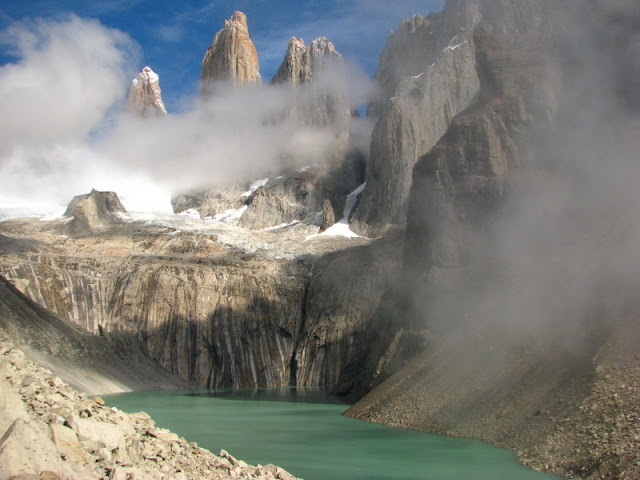 |
| Us with the Torres del Paine in the background. |
Day 1: Camping Las Torres to Campamento Las Torres (9km)
Our route was essentially a “W” (duh). Up one arm of the “W” the first day. The second day included a side trek to the Torres del Paine, which give the park its name, then down to the middle arm of the “W.” Up the middle on Day 3, up the final arm on Day 4, then back out of the park on Day 5.
Map: How to hike the "W" in Torres del Paine
Unfortunately, we didn’t get off to the best start. It rained the first night (at least our tent was still holding up — we met two Israeli guys who were using rain jackets to keep water out of their tent, which was built for the Negev desert). And though we fortunately didn’t get soaked the first day of hiking, the clouds didn’t lift at all and there was almost nothing to see.
But the idea was mostly to get up to the campsite so we could rise early the next morning to see the light hit the towers at sunrise. We made it to the camp in plenty of time, unloaded, and started to make dinner when we discovered our stove had broken! (It's a liquid-fuel pump that relies on a pressurized fuel bottle to work, and the pump was busted.) Bad news. We managed to borrow one from the park ranger for the night, but weren’t sure what we would do about the rest of the hike.
Day 2: Campamento Las Torres to Mirador Las Torres to Camping Las Torres (13km)
Map: How to hike the "W" in Torres del Paine
Unfortunately, we didn’t get off to the best start. It rained the first night (at least our tent was still holding up — we met two Israeli guys who were using rain jackets to keep water out of their tent, which was built for the Negev desert). And though we fortunately didn’t get soaked the first day of hiking, the clouds didn’t lift at all and there was almost nothing to see.
But the idea was mostly to get up to the campsite so we could rise early the next morning to see the light hit the towers at sunrise. We made it to the camp in plenty of time, unloaded, and started to make dinner when we discovered our stove had broken! (It's a liquid-fuel pump that relies on a pressurized fuel bottle to work, and the pump was busted.) Bad news. We managed to borrow one from the park ranger for the night, but weren’t sure what we would do about the rest of the hike.
Day 2: Campamento Las Torres to Mirador Las Torres to Camping Las Torres (13km)
At sunrise the next morning, we were not at the towers but asleep in our tent, which had begun to leak. Since it was still cloudy and raining and since we now didn’t have a stove, we re-evaluated our entire plan. Instead of rushing out that morning, we hung around camp hoping the clouds would eventually clear so we could get a view of the Torres.
They did, and we were glad we waited around, because getting up there was one of the best parts of the hike.
Then we headed halfway back down to one of the refugios (private lodges in the park that offer food and beds for a hefty price), hoping we could rent a stove there. They didn’t have any so we continued back to base. Long story short about the stove: We were carrying a liquid one, and after it broke, we bought a gas canister and mooched a stove from fellow hikers the rest of the way. And starting with Antonio (a nice Chilean who was hiking the “Circuit” on his own), everyone was thankfully supernice about sharing.
Day 3: Camping Las Torres to Refugio Cuernos (11km)
We were now back on track with the official hike, having solved the stove problem. The “W” trek is designed so that the highlights basically correspond with the tips of the “W.” Since we were traveling from one arm to the next arm today, there weren’t a lot of highlights, just a large turquoise blue lake, some tall mountains, and a gradual rolling trail.
It was a nice pleasant day, not too tiring, and we reached our campsite in plenty of time to make a pasta, sausage, onion, and garlic stir-fry for dinner, with a pisco sour from the refugio. If you think that sounds good as a normal dinner, think how delicious we found it after on our third night of camping. Yummy.
- Steph
Keep reading ...






















































